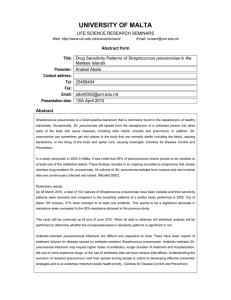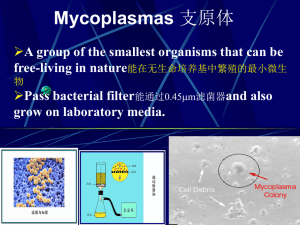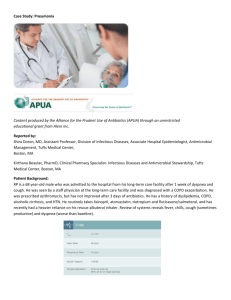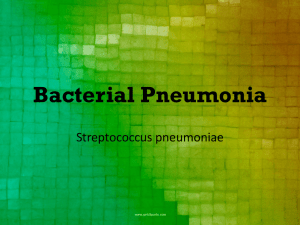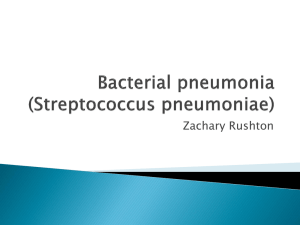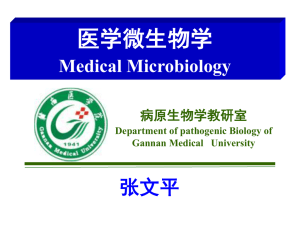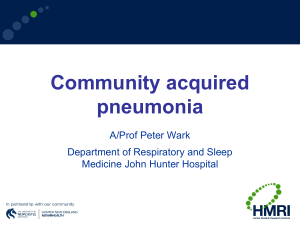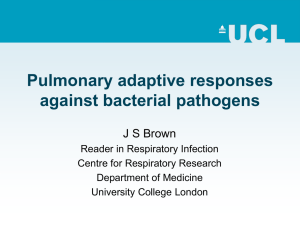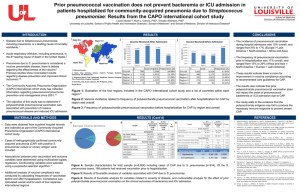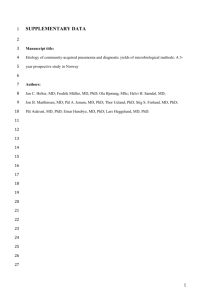No 7: S. pneumoniae Urinary Antigen
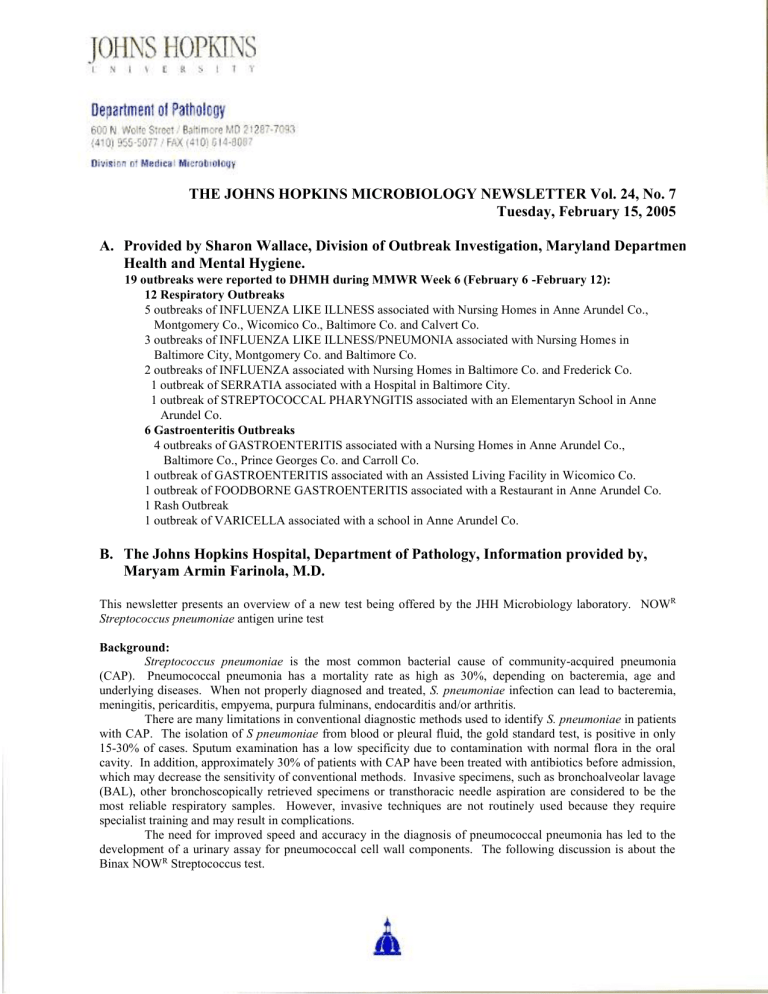
THE JOHNS HOPKINS MICROBIOLOGY NEWSLETTER Vol. 24, No. 7
Tuesday, February 15, 2005
A. Provided by Sharon Wallace, Division of Outbreak Investigation, Maryland Department of
Health and Mental Hygiene.
19 outbreaks were reported to DHMH during MMWR Week 6 (February 6 -February 12):
12 Respiratory Outbreaks
5 outbreaks of INFLUENZA LIKE ILLNESS associated with Nursing Homes in Anne Arundel Co.,
Montgomery Co., Wicomico Co., Baltimore Co. and Calvert Co.
3 outbreaks of INFLUENZA LIKE ILLNESS/PNEUMONIA associated with Nursing Homes in
Baltimore City, Montgomery Co. and Baltimore Co.
2 outbreaks of INFLUENZA associated with Nursing Homes in Baltimore Co. and Frederick Co.
1 outbreak of SERRATIA associated with a Hospital in Baltimore City.
1 outbreak of STREPTOCOCCAL PHARYNGITIS associated with an Elementaryn School in Anne
Arundel Co.
6 Gastroenteritis Outbreaks
4 outbreaks of GASTROENTERITIS associated with a Nursing Homes in Anne Arundel Co.,
Baltimore Co., Prince Georges Co. and Carroll Co.
1 outbreak of GASTROENTERITIS associated with an Assisted Living Facility in Wicomico Co.
1 outbreak of FOODBORNE GASTROENTERITIS associated with a Restaurant in Anne Arundel Co.
1 Rash Outbreak
1 outbreak of VARICELLA associated with a school in Anne Arundel Co.
B. The Johns Hopkins Hospital, Department of Pathology, Information provided by,
Maryam Armin Farinola, M.D.
This newsletter presents an overview of a new test being offered by the JHH Microbiology laboratory. NOW R
Streptococcus pneumoniae antigen urine test
Background:
Streptococcus pneumoniae is the most common bacterial cause of community-acquired pneumonia
(CAP). Pneumococcal pneumonia has a mortality rate as high as 30%, depending on bacteremia, age and underlying diseases. When not properly diagnosed and treated, S. pneumoniae infection can lead to bacteremia, meningitis, pericarditis, empyema, purpura fulminans, endocarditis and/or arthritis.
There are many limitations in conventional diagnostic methods used to identify S. pneumoniae in patients with CAP. The isolation of S pneumoniae from blood or pleural fluid, the gold standard test, is positive in only
15-30% of cases. Sputum examination has a low specificity due to contamination with normal flora in the oral cavity. In addition, approximately 30% of patients with CAP have been treated with antibiotics before admission, which may decrease the sensitivity of conventional methods. Invasive specimens, such as bronchoalveolar lavage
(BAL), other bronchoscopically retrieved specimens or transthoracic needle aspiration are considered to be the most reliable respiratory samples. However, invasive techniques are not routinely used because they require specialist training and may result in complications.
The need for improved speed and accuracy in the diagnosis of pneumococcal pneumonia has led to the development of a urinary assay for pneumococcal cell wall components. The following discussion is about the
Binax NOW R Streptococcus test.
Test procedure and instructions:
Page 1 of 3
The Binax NOW R Streptococcus pneumoniae Test is an immunochromatographic membrane assay test (ICT) used to detect pneumococcal soluble antigen in human urine. In contrast to other bacterial antigen tests, which detect capsular antigens, the ICT detects the S. pneumoniae C-polysaccharide which is found in the cell wall and is common to all serotypes.
Collect urine specimens in standard containers and transport to the laboratory at room temperature within 24 hours of collection. To perform the test, a swab is dipped into the specimen, removed, and then inserted into the test device. Reagent A, a buffer solution, is added from a dropper bottle. Pneumococcal antigen present in the sample reacts to bind anti-S. pneumoniae conjugated antibody. The resulting antigen-conjugate complexes are captured by immobilized anti-S. pneumoniae antibody, forming the
Sample Line. Immobilized control antibody captures anti-species conjugate, forming the Control Line.
Test results are interpreted by the presence or absence of visually detectable pink-to-purple colored lines.
A positive test result, read in 15 minutes or less depending on the concentration of antigen present in the specimen, will include the detection of both a Sample and a Control Line. A negative test result, read in 15 minutes, will produce only a control Line. Failure of the Control Line to appear, whether the Sample Line is present or not, indicates as invalid assay.
Test performance and indication:
The United States Food and Drug Administration (FDA) approved the use of the Binax NOW R urinary assay in 2003. The reported sensitivity of this assay ranges from 70 to 90 percent; specificity is 80 to 100 percent in adults with pneumonia, but is lower in children and in the setting of nasopharyngeal carriage without infection. According to the Infectious Diseases Society of America (IDSA), the pneumococcal urinary antigen assay is an acceptable test to augment the standard diagnostic methods of blood culture and sputum Gram stain and culture, with the potential advantages of rapid results similar to those for sputum Gram stain, and efficacy in patients already treated with antibiotics.
Study
Table 1 summarizes some of the recently published literature on the assay’s performance.
Table 1
Sensitivity (%) Specificity (%)
Gutierrez et al. (2003) 3
Ishida et al. (2004) 4
Rosen et al. (2004) 6
Total No. of cases
452
349
220
Population
Studied
Adults > 15 yrs.
Adults >15 yrs.
Mildly
70.4
75.9
65.9
89.7
94.0
100.0
Smith et al. (2004) 7 107 immunosuppressed adults
Hospitalized bacteremic adults
> 16
82.0 100.0
Test Limitations:
The Binax NOW Streptococcus pneumoniae Test has been validated using urine and CSF samples only. Other samples (e.g. plasma or other body fluids) that may contain S. pneumoniae antigen have not been evaluated. A negative test does not exclude infection with S. pneumoniae . Therefore, the results of this test as well as culture results, serology or other antigen detection methods should be used in conjunction with clinical findings to make an accurate diagnosis. The test has not been evaluated on patients taking antibiotics for greater than 24 hours or on patients who have recently completed an antibiotic regimen. Streptococcus pneumoniae vaccine may cause false positive results in the urine test 48 hours following vaccination. The accuracy has not been proven in young children. Children likely to be asymptomatic carriers of pneumococci than are adults.
are more
Rates of nasopharyngeal colonization among 2 5-year-old children in the United States typically range from 30% to 50%. Due to the high rate of nasopharyngeal colonization the pediatric patient population has a much higher false positive rate.
1,2
References:
1.
Dowell SF, Garman RL, Liu G, et al. Evaluation of Binax NOW, an assay for the detection of pneumococcal antigen in urine samples, performed among pediatric patients. Clin Infect Dis 2001;
32 (824-825)
Page 2 of 3
2.
Hamer DH, Egas J, Estrella B, et al. Assessment of the Binax NOW Streptococcus pneumoniae urinary antigen test in children with nasopharyngeal pneumococcal carriage. Clin Infect Dis
2002;34 (1025-1028).
3.
Gutierrez, F, Masia, M, Rodriguez, JC, et al. Evaluation of the immunochromatographic Binax
NOW assay for detection of Streptococcus pneumoniae urinary antigen in a prospective study of community-acquired pneumonia in Spain. Clin Infect Dis 2003; 36:286.
4.
Ishida T, Hashimoto T, Arita M, et al. A 3-year prospective study of a urinary antigen-detection test for Streptococcus pneumoniae in community-acquired pneumonia: utility and clinical impact on the reported etiology. J Infect Chemother 2004;10:359-363.
5.
Marcos, MA, Jimenez de, Anta MT, de la, Bellacasa JP, et al. Rapid urinary antigen test for diagnosis of pneumococcal community-acquired pneumonia in adults. Eur Respir J 2003; 21:209.
6.
Rosen B, Fernandez-Sabe N, Carratala J, et al. Contribution of a urinary antigen assay (Binax
NOW) to the early diagnosis of pneumococcal pneumonia. Clin Infect Dis 2004; 38 (222-6).
7.
Smith MD, Derrington P, Evans R, et al. Rapid diagnosis of bacteremic pneumococcal infections in adults by using the Binax NOW Streptococcus pneumoniae urinary antigen test: a prospective, controlled clinical evaluation. J Clin Microbiol 2003;41(7):2810-3.
8.
Package insert. NOW Streptococcus pneumoniae Test. Binax Laboratory.
